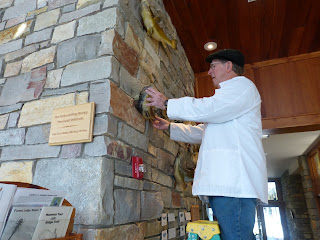Meet the Museum's Fish
When the Museum was due to change out its conspicuous elk display, an appropriate replacement felt inconceivable. What better to welcome visitors to our area's biological diversity than such a towering, majestic symbol of Northwoods forests? Elk have become an important part of our Northwoods culture, but so too have many other flora and fauna here. As I think back to a childhood trip to Hayward, or of the reasons for countless others to visit here, one type of animal feels particularly significant--fish.
The Museum's humble collection of fish mounts is representative of most Wisconsin species, and any visitor could likely name off a few without ever casting a rod or studying any particular species in depth. From bluegill to muskellunge, a variety of freshwater fish species thrive in our local water bodies.
Mounts installed in the Museum's lobby include many well-known panfish like the small bluegill or crappies. Black crappies are particularly prevalent in the Northwoods because of their preference for clear, cool lakes. Smallmouth bass similarly require clean, cool habitat and are good indicators of a healthy waterbody. Visitors can now compare smallmouth and largemouth bass on display, see the size range between two white crappie mounts, or marvel at our larger specimens of burbot and muskellunge. Each have unique adaptations to life in our beloved water bodies. Thanks to the difficult art of fish taxidermy, more of us can experience these creatures from a terrestrial perspective.
 |
| Installing displays often requires some handiwork. In this case, staff climbed a ladder to hang mounts where they will be safe from curious hands. |
Most of these mounts have been prepared by carefully skinning the fish and mounting it over a form. The real head is often used, as well as the fins and tail. What makes fish perhaps the most difficult type of taxidermy subject is not their delicately thin parts, but that they lose much of their color as they dry. Those who prepare a fish usually apply a great deal of artistry to their work, as the color pattern must be recreated by painting the entire fish with an airbrush.
Often these days, mounts don't actually utilize any parts from the real fish. Rather, fish are caught, their size, weight and characteristics are measured, and they are released. Mounts are made from accurate molds and then airbrushed by a professional to mimic the color patterning of that particular fish. This method is both more sustainable and requires less effort from the taxidermist to preserve the skin of a fish.
 |
| This black crappie specimen was created using a graphite mold. Fish of the same species can vary in size, color, and patterning. |
While we often associate taxidermy with birds or mammals, the preservation of fish in this manner proves just as educational and fascinating. Fish can easily be compared, examined visually, and when not in a museum, touched with ease. The recent installment of our fish display trails upward from an adjacent wood carving of Wisconsin fish by Charlie Dutter, and both forms of art are just some of the ways in which people interpret important components of the world around us.

